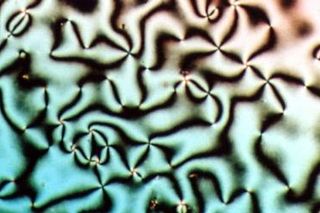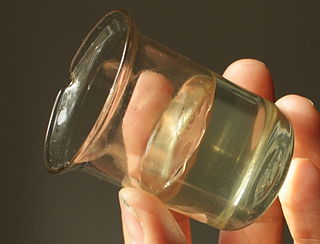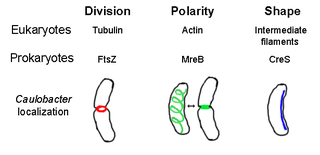Related Research Articles

In cell biology, the cytoplasm describes all material within a eukaryotic cell, enclosed by the cell membrane, except for the cell nucleus. The material inside the nucleus and contained within the nuclear membrane is termed the nucleoplasm. The main components of the cytoplasm are the cytosol, the organelles, and various cytoplasmic inclusions. The cytoplasm is about 80% water and is usually colorless.

Cellulose is an organic compound with the formula (C
6H
10O
5)
n, a polysaccharide consisting of a linear chain of several hundred to many thousands of β(1→4) linked D-glucose units. Cellulose is an important structural component of the primary cell wall of green plants, many forms of algae and the oomycetes. Some species of bacteria secrete it to form biofilms. Cellulose is the most abundant organic polymer on Earth. The cellulose content of cotton fiber is 90%, that of wood is 40–50%, and that of dried hemp is approximately 57%.

Liquid crystal (LC) is a state of matter whose properties are between those of conventional liquids and those of solid crystals. For example, a liquid crystal can flow like a liquid, but its molecules may be oriented in a common direction as in a solid. There are many types of LC phases, which can be distinguished by their optical properties. The contrasting textures arise due to molecules within one area of material ("domain") being oriented in the same direction but different areas having different orientations. An LC material may not always be in an LC state of matter.

Actin is a family of globular multi-functional proteins that form microfilaments in the cytoskeleton, and the thin filaments in muscle fibrils. It is found in essentially all eukaryotic cells, where it may be present at a concentration of over 100 μM; its mass is roughly 42 kDa, with a diameter of 4 to 7 nm.

Phalloidin belongs to a class of toxins called phallotoxins, which are found in the death cap mushroom (Amanita phalloides). It is a rigid bicyclic heptapeptide that is lethal after a few days when injected into the bloodstream. The major symptom of phalloidin poisoning is acute hunger due to the destruction of liver cells. It functions by binding and stabilizing filamentous actin (F-actin) and effectively prevents the depolymerization of actin fibers. Due to its tight and selective binding to F-actin, derivatives of phalloidin containing fluorescent tags are used widely in microscopy to visualize F-actin in biomedical research.

Filamentous bacteriophages are a family of viruses (Inoviridae) that infect bacteria, or bacteriophages. They are named for their filamentous shape, a worm-like chain, about 6 nm in diameter and about 1000-2000 nm long. This distinctive shape reflects their method of replication: the coat of the virion comprises five types of viral protein, which are located in the inner membrane of the host bacterium during phage assembly, and these proteins are added to the nascent virion's DNA as it is extruded through the membrane. The simplicity of filamentous phages makes them an appealing model organism for research in molecular biology, and they have also shown promise as tools in nanotechnology and immunology.

Plasmodesmata are microscopic channels which traverse the cell walls of plant cells and some algal cells, enabling transport and communication between them. Plasmodesmata evolved independently in several lineages, and species that have these structures include members of the Charophyceae, Charales, Coleochaetales and Phaeophyceae, as well as all embryophytes, better known as land plants. Unlike animal cells, almost every plant cell is surrounded by a polysaccharide cell wall. Neighbouring plant cells are therefore separated by a pair of cell walls and the intervening middle lamella, forming an extracellular domain known as the apoplast. Although cell walls are permeable to small soluble proteins and other solutes, plasmodesmata enable direct, regulated, symplastic transport of substances between cells. There are two forms of plasmodesmata: primary plasmodesmata, which are formed during cell division, and secondary plasmodesmata, which can form between mature cells.

Coacervate is an aqueous phase rich in macromolecules such as synthetic polymers, proteins or nucleic acids. It forms through liquid-liquid phase separation (LLPS), leading to a dense phase in thermodynamic equilibrium with a dilute phase. The dispersed droplets of dense phase are also called coacervates, micro-coacervates or coacervate droplets. These structures draw a lot of interest because they form spontaneously from aqueous mixtures and provide stable compartmentalization without the need of a membrane—they are protocell candidates.

Lyotropic liquid crystals result when amphiphiles, which are both hydrophobic and hydrophilic, dissolve into a solution that behaves both like a liquid and a solid crystal. This liquid crystalline mesophase includes everyday mixtures like soap and water.

Actin, alpha skeletal muscle is a protein that in humans is encoded by the ACTA1 gene.

The prokaryotic cytoskeleton is the collective name for all structural filaments in prokaryotes. It was once thought that prokaryotic cells did not possess cytoskeletons, but advances in visualization technology and structure determination led to the discovery of filaments in these cells in the early 1990s. Not only have analogues for all major cytoskeletal proteins in eukaryotes been found in prokaryotes, cytoskeletal proteins with no known eukaryotic homologues have also been discovered. Cytoskeletal elements play essential roles in cell division, protection, shape determination, and polarity determination in various prokaryotes.

The UDP-forming form of cellulose synthase is the main enzyme that produces cellulose. Systematically, it is known as UDP-glucose:(1→4)-β-D-glucan 4-β-D-glucosyltransferase in enzymology. It catalyzes the chemical reaction:

Moesin is a protein that in humans is encoded by the MSN gene.

ACTC1 encodes cardiac muscle alpha actin. This isoform differs from the alpha actin that is expressed in skeletal muscle, ACTA1. Alpha cardiac actin is the major protein of the thin filament in cardiac sarcomeres, which are responsible for muscle contraction and generation of force to support the pump function of the heart.

Alpha-actinin-4 is a protein that in humans is encoded by the ACTN4 gene.

Actin, gamma-enteric smooth muscle is a protein that in humans is encoded by the ACTG2 gene.

Prefoldin subunit 1 is a protein that in humans is encoded by the PFDN1 gene.

TRIO and F-actin-binding protein is a protein that in humans is encoded by the TRIOBP gene.

DNA condensation refers to the process of compacting DNA molecules in vitro or in vivo. Mechanistic details of DNA packing are essential for its functioning in the process of gene regulation in living systems. Condensed DNA often has surprising properties, which one would not predict from classical concepts of dilute solutions. Therefore, DNA condensation in vitro serves as a model system for many processes of physics, biochemistry and biology. In addition, DNA condensation has many potential applications in medicine and biotechnology.

In biochemistry, biomolecular condensates are a class of membrane-less organelles and organelle subdomains, which carry out specialized functions within the cell. Unlike many organelles, biomolecular condensate composition is not controlled by a bounding membrane. Instead, condensates can form and maintain organization through a range of different processes, the most well-known of which is phase separation of proteins, RNA and other biopolymers into either colloidal emulsions, gels, liquid crystals, solid crystals or aggregates within cells.
References
- ↑ Zocher, H. (1925). "Über freiwillige Strukturbildung in Solen. (Eine neue Art anisotrop flüssiger Medien)". Zeitschrift für anorganische und allgemeine Chemie. 147: 91–110. doi:10.1002/zaac.19251470111.
- ↑ Bawden, F. C.; Pirie, N. W.; Bernal, J. D.; Fankuchen, I. (1936). "Liquid crystalline substances from virus-infected plants". Nature. 138 (3503): 1051. Bibcode:1936Natur.138.1051B. doi:10.1038/1381051a0.
- ↑ Robinson, Conmar (1956). "Liquid-crystalline structures in solutions of a polypeptide". Transactions of the Faraday Society. 52: 571. doi:10.1039/TF9565200571.
- ↑ Revol, J.-F.; Bradford, H.; Giasson, J.; Marchessault, R.H.; Gray, D.G. (1992). "Helicoidal self-ordering of cellulose microfibrils in aqueous suspension". International Journal of Biological Macromolecules. 14 (3): 170–172. doi:10.1016/S0141-8130(05)80008-X. PMID 1390450.
- ↑ Weirich, Kimberly L.; Banerjee, Shiladitya; Dasbiswas, Kinjal; Witten, Thomas A.; Vaikuntanathan, Suriyanarayanan; Gardel, Margaret L. (2017-02-28). "Liquid behavior of cross-linked actin bundles". Proceedings of the National Academy of Sciences. 114 (9): 2131–2136. Bibcode:2017PNAS..114.2131W. doi: 10.1073/pnas.1616133114 . ISSN 0027-8424. PMC 5338483 . PMID 28202730.
- ↑ Secor, Patrick R.; Sweere, Johanna M.; Michaels, Lia A.; Malkovskiy, Andrey V.; Lazzareschi, Daniel; Katznelson, Ethan; Rajadas, Jayakumar; Birnbaum, Michael E.; Arrigoni, Allison; Braun, Kathleen R.; Evanko, Stephen P.; Stevens, David A.; Kaminsky, Werner; Singh, Pradeep K.; Parks, William C.; Bollyky, Paul L. (2015). "Filamentous Bacteriophage Promote Biofilm Assembly and Function". Cell Host & Microbe. 18 (5): 549–559. doi:10.1016/j.chom.2015.10.013. PMC 4653043 . PMID 26567508.